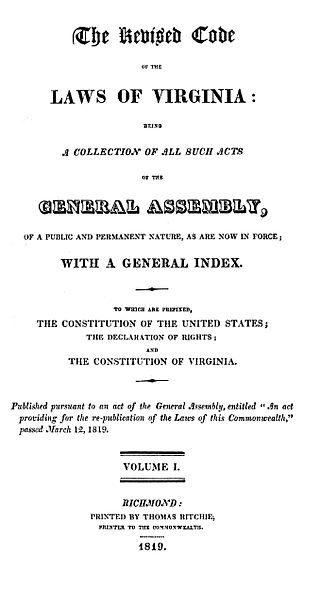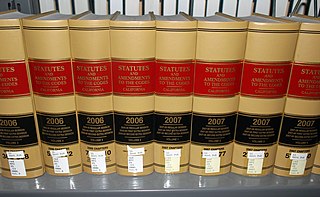Related Research Articles

The United States Code is the official codification of the general and permanent federal statutes of the United States. It contains 53 titles. The main edition is published every six years by the Office of the Law Revision Counsel of the House of Representatives, and cumulative supplements are published annually. The official version of these laws appears in the United States Statutes at Large, a chronological, uncodified compilation.
The government of California is the governmental structure of the U.S. state of California as established by the California Constitution. California uses the separation of powers system to structure its government. It is composed of three branches: the executive, consisting of the governor of California and the other constitutionally elected and appointed officers and offices; the legislative, consisting of the California State Legislature, which includes the Assembly and the Senate; and the judicial, consisting of the Supreme Court of California and lower courts. There is also local government, consisting of counties, cities, special districts, and school districts, as well as government entities and offices that operate independently on a constitutional, statutory, or common law basis. The state also allows direct participation of the electorate by initiative, referendum, recall and ratification.
In law, codification is the process of collecting and restating the law of a jurisdiction in certain areas, usually by subject, forming a legal code, i.e. a codex (book) of law.

The Code of Virginia is the statutory law of the U.S. state of Virginia and consists of the codified legislation of the Virginia General Assembly. The 1950 Code of Virginia is the revision currently in force. The previous official versions were the Codes of 1819, 1849, 1887, and 1919, though other compilations had been printed privately as early as 1733, and other editions have been issued that were not designated full revisions of the code.

The Connecticut General Statutes, also called the General Statutes of Connecticut and abbreviated Conn. Gen. Stat., is a codification of the law of Connecticut. Revised to 2017, it contains all of the public acts of Connecticut and certain special acts of the public nature, the Constitution of the United States, the Amendments to the Constitution of the United States, and the Constitution of the State of Connecticut, including its 31 amendments adopted since 1965. The earliest predecessor to the currently in force codification dates to 1650.
Title 14 of the United States Code is a positive law title of the United States Code concerning the United States Coast Guard.

The California Vehicle Code, informally referred to as the Veh. Code or the CVC, is the section of the California Codes which contains almost all statutes relating to the operation, ownership and registration of vehicles in the state of California in the United States. The Vehicle Code's "Rules of the Road" generally apply to operating vehicles, bicycles, and animals on a public roadway, except for provisions which by their very nature can have no application. The Vehicle Code also contains statutes concerning the California Department of Motor Vehicles and the California Highway Patrol.

The California Codes are 29 legal codes enacted by the California State Legislature, which, alongside uncodified acts, form the general statutory law of California. The official Codes are maintained by the California Office of Legislative Counsel for the Legislature. The Legislative Counsel also publishes the official text of the Codes publicly at leginfo.legislature.ca.gov.

California Statutes are the acts of the California State Legislature as approved according to the California Constitution and collated by the Secretary of State of California.

The law of California consists of several levels, including constitutional, statutory, and regulatory law, as well as case law. The California Codes form the general statutory law, and most state agency regulations are available in the California Code of Regulations.

The Civil Code of California is a collection of statutes for the State of California. The code is made up of statutes which govern the general obligations and rights of persons within the jurisdiction of California. It was based on a civil code originally prepared by David Dudley Field II in 1865 for the state of New York. It is one of the 29 California Codes and was among the first four enacted in 1872.

The Annotated Code of Maryland, published by The Michie Company, is the official codification of the statutory laws of Maryland. It is organized into 36 named articles. The previous code, organized into numbered articles, has been repealed.
The California Art Preservation Act (CAPA) is a 1979 California law that provides legal protection for artists' moral rights by prohibiting the alteration or destruction of their artwork without their consent. The law has since been amended in part. The law is codified at California Civil Code § 987. The California Art Preservation Act was the first major law to specifically address artists' rights in the United States.

The California Public Records Act was a law passed by the California State Legislature and signed by governor Ronald Reagan in 1968 requiring inspection or disclosure of governmental records to the public upon request, unless exempted by law.
The law of Virginia consists of several levels of legal rules, including constitutional, statutory, regulatory, case law, and local laws. The Code of Virginia contains the codified legislation that define the general statutory laws for the Commonwealth.
The law of the U.S. state of Georgia consists of several levels, including constitutional, statutory, and regulatory law, as well as case law and local law. The Official Code of Georgia Annotated forms the general statutory law.
Laws regarding incest in the United States vary widely between jurisdictions regarding both the definition of the offense and penalties for its commission.
Georgia v. Public.Resource.Org, Inc., No. 18-1150, 590 U.S. ___ (2020), is a United States Supreme Court case regarding "whether the government edicts doctrine extends to—and thus renders uncopyrightable—works that lack the force of law, such as the annotations in the Official Code of Georgia Annotated" (OCGA). On April 27, 2020, the Court ruled 5–4 that the OCGA cannot be copyrighted because the OCGA's annotations were "authored by an arm of the legislature in the course of its legislative duties"; thus the Court found that the annotations fall under the government edicts doctrine and are ineligible for copyright.
The Code of the District of Columbia is the codification of the general and permanent laws relating to the District of Columbia. It was enacted and is revised by authority of the Congress of the United States.
References
- ↑ "Article 2 of Chapter 3.5 of Division 1 of Title 2 of the California Government Code". California Office of Legislative Counsel . Retrieved February 12, 2019.
- ↑ Asimow, Michael (1999). "Speed Bumps on the Road to Administrative Law Reform in California and Pennsylvania". Widener Journal of Law and Public Policy: 3. doi:10.2139/ssrn.148700.
- ↑ "California Law Revision Commission Home". California Law Review Commission. Retrieved 2024-06-21.
- ↑ California Government Code § 8280
- ↑ California Government Code § 8293
- ↑ See 2006 Cal. Stat. res. ch. 128. See also Nonsubstantive Reorganization of Deadly Weapon Statutes, 38 Cal. L. Revision Comm’n Reports 217 (2009) enacted by 2010 Cal. Stat. ch. 178 and 2010 Cal. Stat. ch. 711.
- ↑ See 2013 Cal. Stat. res. ch. 115
- ↑ Recommendation Proposing an Evidence Code, 7 Cal. L. Revision Comm'n Reports 1001 (1965)
- ↑ California Government Code § 8281
- ↑ "Personnel Listing". Archived from the original on 2013-10-19. Retrieved 2013-10-18.
- ↑ Korte, Lara; Gardiner, Dustin (2024-06-20). "Mike Madrid has a warning for Dems ahead of November". Politico. Retrieved 2024-06-21.